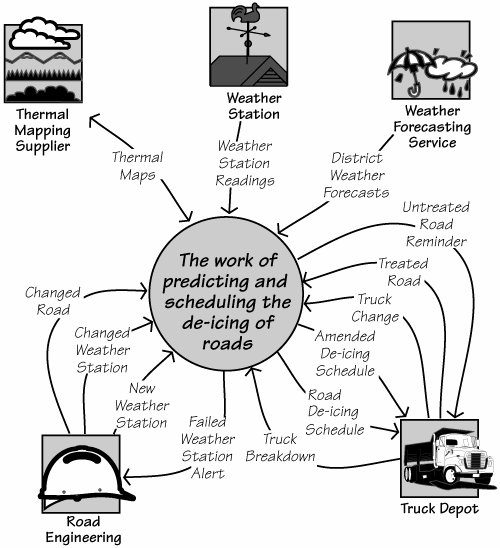The Context of the Work
| To understand the work, you must first know how it relates to the world outside it. The work exists to provide services to the outside world. To provide those services, the work must receive information and signals from the outside world and send messages to it. This world is made up of the adjacent systems, which are the automated systems, people, departments, organizations, and other parties that place some kind of demand on, or make some kind of contribution to, your work. To locate your work in the outside world, you must be able to demonstrate its contexthow the work connects to the adjacent systems. In other words, your context model shows how your work relates to its business environment. The most convenient and useful way to show the work's connections to the outside world is to use a context diagram. Figure 4.2 provides the context diagram for the work of predicting when roads are due to freeze and scheduling trucks to treat them with de-icing material. (This diagram also appeared in Chapter 3.) The work is surrounded by adjacent systems that are supplying data necessary for this work or receiving services and information from the work. Figure 4.2.The context diagram showing the scope of the work. The central area of the diagram represents the work you are about to study. The product you eventually build becomes part of this work. The outside world is represented by the adjacent systemsWeather Station, Truck Depot, and so on. The named arrows represent flows of information between the adjacent systems and the work.
The work to be studied must include anything that can be affected by your product. The work to be studied must include anything that can be affected by your product. For example, if you are building a product intended to automate part of some existing work, then the study context should include those parts of the existing workhuman activities, together with any existing computer systemsthat could potentially influence the eventual product. For embedded systems, there may be no human activity in your work, but the work context must include any devices that can be changed by the current development. Even if you are building an electro-mechanical device, such as an automated teller machine (ATM), and most of the human participation is outside the product boundary, your work context must still include the work that the human will be doing with the device. While we are talking about the context, note the limited, but nevertheless useful, aim of the model. This model shows only the flows of information. It does not attempt to show the constraints upon the work, although these may be inferred from the model. It does not explicitly show who or what is doing the work, although these, too, might be inferred. Like most models, the context model shows a single view. In this case, by illuminating the flows of information, we are able to make better use of the model for determining the business events affecting the work. But first, let's look at one part of the context model in more detail: the outside world.
|
EAN: 2147483647
Pages: 371
- ERP Systems Impact on Organizations
- Enterprise Application Integration: New Solutions for a Solved Problem or a Challenging Research Field?
- Distributed Data Warehouse for Geo-spatial Services
- Relevance and Micro-Relevance for the Professional as Determinants of IT-Diffusion and IT-Use in Healthcare
- Development of Interactive Web Sites to Enhance Police/Community Relations
